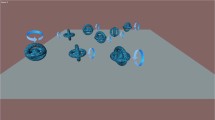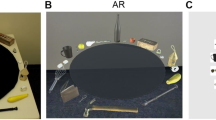Abstract
A three-quarter view, i.e., an oblique view, of familiar objects often leads to a higher subjective goodness rating when compared with other orientations. What is the source of the high goodness for oblique views? First, we confirmed that object recognition performance was also best for oblique views around 30° view, even when the foreshortening disadvantage of front- and side-views was minimized (Experiments 1 and 2). In Experiment 3, we measured subjective ratings of view goodness and two possible determinants of view goodness: familiarity of view, and subjective impression of three-dimensionality. Three-dimensionality was measured as the subjective saliency of visual depth information. The oblique views were rated best, most familiar, and as approximating greatest three-dimensionality on average; however, the cluster analyses showed that the “best” orientation systematically varied among objects. We found three clusters of objects: front-preferred objects, oblique-preferred objects, and side-preferred objects. Interestingly, recognition performance and the three-dimensionality rating were higher for oblique views irrespective of the clusters. It appears that recognition efficiency is not the major source of the three-quarter view advantage. There are multiple determinants and variability among objects. This study suggests that the classical idea that a canonical view has a unique advantage in object perception requires further discussion.















Similar content being viewed by others
References
Biederman, I. (2000). Recognizing depth-rotated objects: A review of recent research and theory. Spatial Vision, 13(2), 241–253.
Biederman, I., & Gerhardstein, P. C. (1993). Recognizing depth-rotated objects: Evidence and conditions for three-dimensional viewpoint invariance. Journal of Experimental Psychology: Human Perception and Performance, 19(6), 1162–1182.
Blanz, V., Tarr, M. J., & Bülthoff, H. H. (1999). What object attributes determine canonical views? Perception, 28(5), 575–599.
Boutsen, L., Lamberts, K., & Verfaillie, K. (1998). Recognition times of different views of 56 depth-rotated objects: A note concerning Verfaillie and Boutsen (1995). Perception and Psychophysics, 60(5), 900–907.
Bramão, I., Ries, A., Petersson, K. M., & Faísca, L. (2011). The role of color information on object recognition: A review and meta-analysis. Acta Psychologica, 138, 244–253.
DiCarlo, J. J., & Cox, D. D. (2007). Untangling invariant object recognition. Trends in Cognitive Sciences, 11(8), 333–341.
Farah, M. J., Wilson, K. D., Maxwell Drain, H., & Tanaka, J. R. (1995). The inverted face inversion effect in prosopagnosia: Evidence for mandatory, face-specific perceptual mechanisms. Vision Research, 35(14), 2089–2093.
Guilford, J. P. (1956). Fundamental statistics in psychology and education (3rd ed.). New York, NY: McGraw Hill.
Humphrey, G. K., & Jolicoeur, P. (1993). An examination of the effects of axis foreshortening, monocular depth cues, and visual field on object identification. The Quarterly Journal of Experimental Psychology Section A: Human Experimental Psychology, 46(1), 137–159.
Humphreys, G. W., & Riddoch, M. J. (1984). Routes to object constancy: Implications from neurological impairments of object constancy. The Quarterly Journal of Experimental Psychology Section A: Human Experimental Psychology, 36(3), 385–415.
Lawson, R. (1999). The effects of view in depth on the identification of line drawings and silhouettes of familiar objects: Normality and pathology. Visual Cognition, 6(2), 165–195.
Lawson, R., & Humphreys, G. W. (1998). View-specific effects of depth rotation and foreshortening on the initial recognition and priming of familiar objects. Perception and Psychophysics, 60(6), 1052–1066.
Lawson, R., Humphreys, G. W., & Jolicœur, P. (2000). The combined effects of plane disorientation and foreshortening on picture naming: One manipulation or two? Journal of Experimental Psychology: Human Perception and Performance, 26(2), 568–581.
Marr, D. (1982). Vision. San Francisco, CA: W H Freeman.
Mitsumatsu, H., & Yokosawa, K. (2002). How do the internal details of the object contribute to recognition? Perception, 31(11), 1289–1298.
Mojena, R. (1977). Hierarchical grouping methods and stopping rules: an evaluation. The Computer Journal, 20(4), 359–363.
Newell, F. N., & Findlay, J. M. (1997). The effect of depth rotation on object identification. Perception, 26(10), 1231–1257.
Niimi, R., & Yokosawa, K. (2009a). Three-quarter views are subjectively good because object orientation is uncertain. Psychonomic Bulletin & Review, 16(2), 289–294.
Niimi, R., & Yokosawa, K. (2009b). Viewpoint dependence in the recognition of non-elongated familiar objects: Testing the effects of symmetry, front–back axis, and familiarity. Perception, 38(4), 533–551.
Palmer, S., Rosch, E., & Chase, P. (1981). Canonical perspective and the perception of objects. In J. Long & A. Baddeley (Eds.), Attention and performance IX (pp. 135–151). Hillsdale, NJ: Erlbaum.
Peissig, J. J., & Tarr, M. J. (2007). Visual object recognition: do we know more now than we did 20 years ago? Annual Review of Psychology, 58, 75–96.
Riesenhuber, M., & Poggio, T. (2000). Models of object recognition. Nature Neuroscience, 3(11s), 1199–1204.
Rolls, E. T. (2012). Invariant visual object and face recognition: Neural and computational bases, and a model. VisNet. Frontiers in Computational Neuroscience, 6(35), 1–70.
Sugio, T., Inui, T., Matuso, K., Matsuzawa, M., Glover, G. H., & Nakai, T. (1999). The role of the posterior parietal cortex in human object recognition: A functional magnetic resonance imaging study. Neuroscience Letters, 276, 45–48.
Tanaka, J. W., & Presnell, L. M. (1999). Color diagnosticity in object recognition. Perception and Psychophysics, 61(6), 1140–1153.
Terhune, K. P., Liu, G. T., Modestino, E. J., Miki, A., Sheth, K. N., Liu, C.-S. J., et al. (2005). Recognition of objects in non-canonical views: A functional MRI study. Journal of Neuro-Ophthalmonogy, 25, 273–279.
Dalal. N., & Triggs, B. (2005). Histograms of oriented gradients for human detection. In Proceedings of the IEEE Conference of Computer Vision and Pattern Recognition (CVPR), 886–893.
Troje, N. F., & Bülthoff, H. H. (1996). Face recognition under varying poses: The role of texture and shape. Vision Research, 36(12), 1761–1771.
Verfaillie, K., & Boutsen, L. (1995). A corpus of 714 full-color images of depth-rotated objects. Perception and Psychophysics, 57(7), 925–961.
Ward, J. H, Jr. (1963). Hierarchical grouping to optimize an objective function. Journal of the American Statistical Association, 58(301), 236–244.
Warrington, E. K., & Taylor, A. M. (1973). The contribution of the right parietal lobe to object recognition. Cortex, 9, 152–164.
Author information
Authors and Affiliations
Corresponding author
Appendices
Appendix 1: Familiar objects used in this study (the 30° view)


Appendix 2: A form for assessing view goodness (originally in Japanese)

Appendix 3: A form for assessing view familiarity (originally in Japanese)

Appendix 4: A form for assessing the subjective impression of three-dimensionality (originally in Japanese)

Appendix 5: Post hoc analyses of the oblique/front/side preferred objects about goodness, familiarity, three-dimensionality, and reaction times

Rights and permissions
About this article
Cite this article
Nonose, K., Niimi, R. & Yokosawa, K. On the three-quarter view advantage of familiar object recognition. Psychological Research 80, 1030–1048 (2016). https://doi.org/10.1007/s00426-015-0702-9
Received:
Accepted:
Published:
Issue Date:
DOI: https://doi.org/10.1007/s00426-015-0702-9




